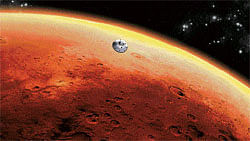
In the third week of this month (November 25), yet another large spacecraft is to be launched to explore Mars. This is the Mars Science Laboratory Mission (MSL) carrying the largest ever rover to explore the surface of Mars. The rover has been named Curiosity and at a size spanning three metres, it is twice as large as the Mars exploration Rovers (launched in 2003) and five times the size of the puny Sojourner rover carried by the Mars Path Finder Mission in 1997.
The MSL will take over eight months (a typical flight duration is 260 days) to reach Mars and is expected to arrive on August 6, 2012. This explains why the recently concluded Mars 500 experiment involved isolation of six volunteers in a large mock spaceship (on the ground) for a duration of 520 days to study whether people can stay sane and healthy for such a typical Martian round trip. The earlier 420-day experiment ended in a drunken disaster because of crew misbehaviour.
Realistic human missions to Mars are several years away, but the past decade has seen several serious attempts to study Mars with unmanned spacecraft carrying sophisticated robotic rovers! For instance, the rovers named Spirit and Opportunity landed on opposite sides of Mars within three weeks of each other in January 2004. These twin rovers (weighing 175 kg), even after seven years, are still sending back valuable information, long after the expected three months.
Exploring the rugged terrain of Gusev crater, the spirit rover revealed resilience to reach the summit of the 80-meter Husband Hill in 2005, in spite of being stuck in a sand pit for nine months. The two rovers uncovered valuable evidence to confirm that Mars was once warmer and more earth-like than it is today, also finding traces of ancient seas, volcanic steam vents, etc and also layered bedrock and minerals that can form only in the presence of water.
Now, Curiosity is expected to touchdown in a flat area on the floor of the 150-km-wide impact crater named Gale. The Gale crater was chosen because of its huge debris mounds and possible eroded sediments containing both sulphate salts and clay minerals. The Laboratory Mission will enter the rarefied Martian air with a huge five-metre heat shield and a 16-metre parachute (largest used for an ET mission) to decelerate the spacecraft to about 300 km/hr at two kilometers above the surface.
Study of Martian climate
Weighing nearly a ton, Curiosity is too massive for the use of air bags to cushion its landing, unlike the Mars exploration rovers or the Sojourner. Instead, use of retro rockets with a complex landing system called the sky crane and finally three cables to slowly lower Curiosity until its six wheels touch the Martian ground, constitute the landing scheme.
Some of the mission goals of the MSL are to measure abundances of bio-elements such as carbon, oxygen, phosphorus etc, to look for possible microscopic structures produced by biological processes, see if organic molecules exist on Mars, determine surface minerals, establish role of water and carbon dioxide in atmospheric cycles, etc. Also more quantitative estimates of radiation risks for future astronauts on the Martian surface would be made. The MSL could also provide valuable information to understand evolution of the Martian climate over the past four billion years and the geological processes that shaped the soil and rocks.
What Curiosity will carry
The Curiosity rover would itself carry heavy hardware with instruments such as the Chemcam, which uses a laser that can vaporise rocks seven metres away, and analyse their spectrum. Other instruments include the radiation assessment detector (RAD), the Mastcam to record high resolution colour video of the surroundings and the Robot arm to gather samples for analysis by internal instruments. The arm also houses the Mars Hand Lens Imager for close-up photos and the Alpha Particle X-ray Spectrometer for analysing rocks.
The sample analysis at Mars (in situ analysis) contains a gas chromatograph, laser mass spectrometer and a Chemin X-ray instrument. In addition, there is the Rover environmental monitoring station (to measure pressure, humidity, temperature, wind speed, UV radiation etc) and dynamic Albedo neutron device to detect hydrogen even one metre below the Martian surface.
Powered by RTG (Radio-isotopic Thermal Generator), Curiosity is supposed to travel a total of more than twenty kilometers during its two year operational life time. Of course, the power supply would last well over ten years and the rover could last longer! Curiosity would also record large numbers of high resolution stereoscopic colour images.
However, it would not be able to search for living or fossil micro-organisms. This is perhaps the task for later missions like the planned Multi-spacecraft EXOMARS project scheduled for 2017.
In short, by the end of 2012 we could be well on the way to understand long-standing puzzles concerning Mars and its evolution.
Deccan Herald is on WhatsApp Channels| Join now for Breaking News & Editor's Picks